It’s perfectly possible to write a great listicle about… well, pretty much anything.
In this post, you’ll learn how to do just that.
- What is a listicle?
- Why do people like listicles?
- How to write a good listicle
- Examples of listicles done well
Listicles, otherwise known as list-posts, are articles structured around lists. Usually, they expand on each list item with additional information to make them more useful for readers.
Here are just a few reasons:
- Easy to skim because each subheading usually corresponds to a list item.
- Easy to digest because they’re broken into bitesize chunks by definition.
- Easy to gauge because you always know how much is left from the number in the title.
Is that an exhaustive list of reasons? No, but we can’t list them all. Check out this post by Smithsonian Magazine if you’re curious about other reasons for their popularity.
Writing a listicle is easy. Just open a blank document, list a bunch of things and you’ve got a listicle. But writing a listicle that drives traffic and that people actually want to read is a bit more complicated.
Here’s how to do it:
- Choose a topic
- Ensure it makes sense
- Decide on length
- Choose a format
- Choose a winning angle
- Brainstorm list points
- Expand on your ideas
- Flesh out each point
- Illustrate your points
- Wrap things up
1. Choose a topic
If you want your listicle to drive traffic from search engines, you need to choose a topic that people are searching for.
Because keywords typically represent topics, you can do this with a good keyword research tool like Ahrefs’ Keywords Explorer. Just search for a broad topic, then go to the Phrase Match report where you’ll see keyword ideas sorted by their monthly search volumes.
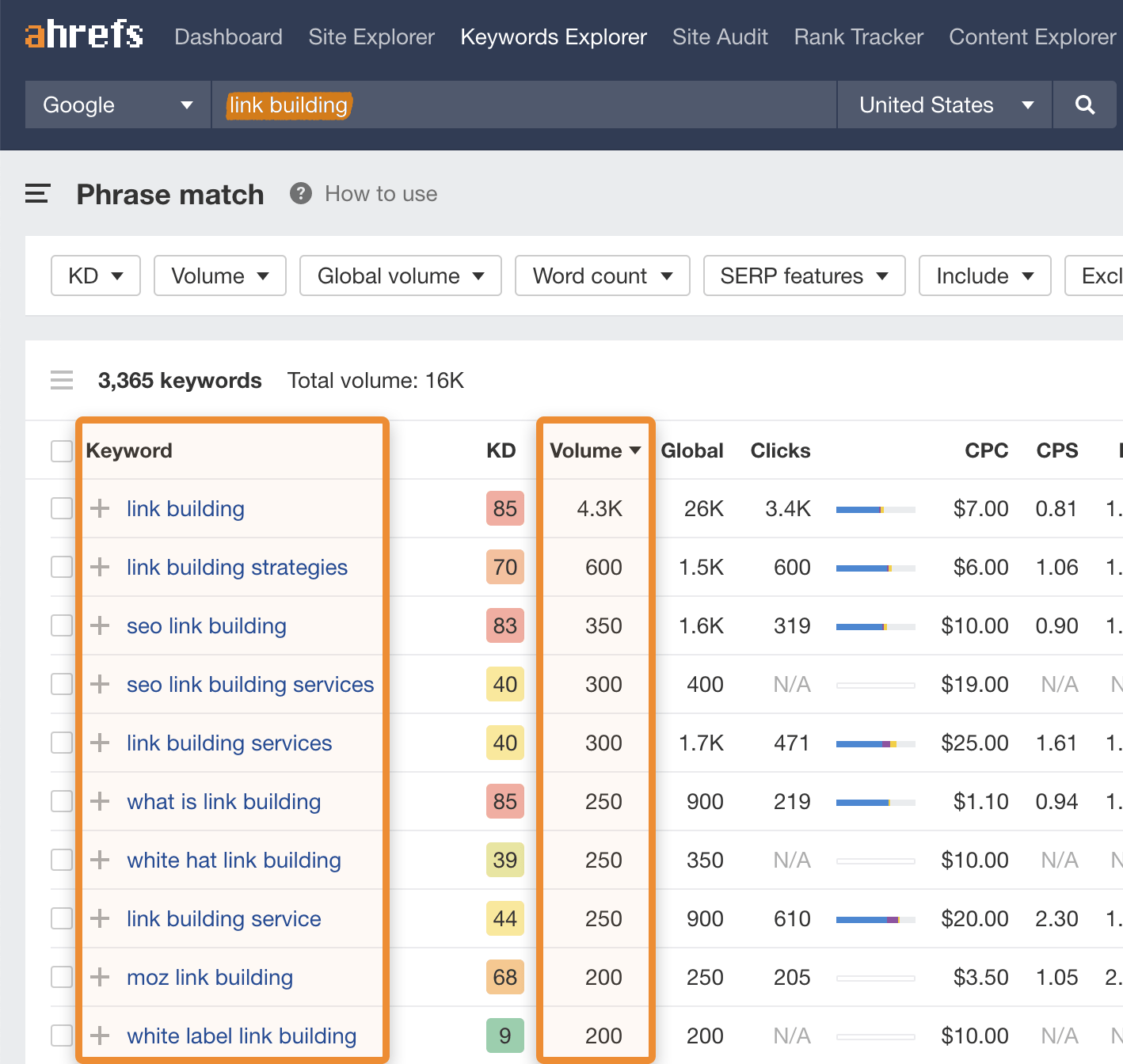
Make sure to choose a topic that you have some knowledge about. Otherwise you’ll struggle to write a unique and valuable list.
2. Ensure it makes sense
Not every topic is suitable for a listicle format. That’s pretty obvious for some topics, like “how to tie a tie.” You can tell from the query that people are looking for a step-by-step process, not a listicle with lots of different methods.
But things aren’t always so obvious…
Take a topic like “seo expert.” It’s not clear whether people want a step-by-step guide, a list of tips, or something else.
You can figure this out by looking at the top-ranking results in Google. Because Google’s business model relies on them delivering relevant search results, the top results are a great proxy for what searchers want to see.

Looking at the screenshot above, you can see that only one listicle ranks in the top five for “seo expert.” As the rest are step-by-step guides, this probably isn’t a good topic for a listicle.
If you’re struggling to find a suitable topic for a listicle, try adding these words to the Include filter in Keywords Explorer: ideas, tips, best, tools, things, strategies, tactics, list. This will narrow the results down to keywords that include at least one of those words, which will often be great candidates for listicles.
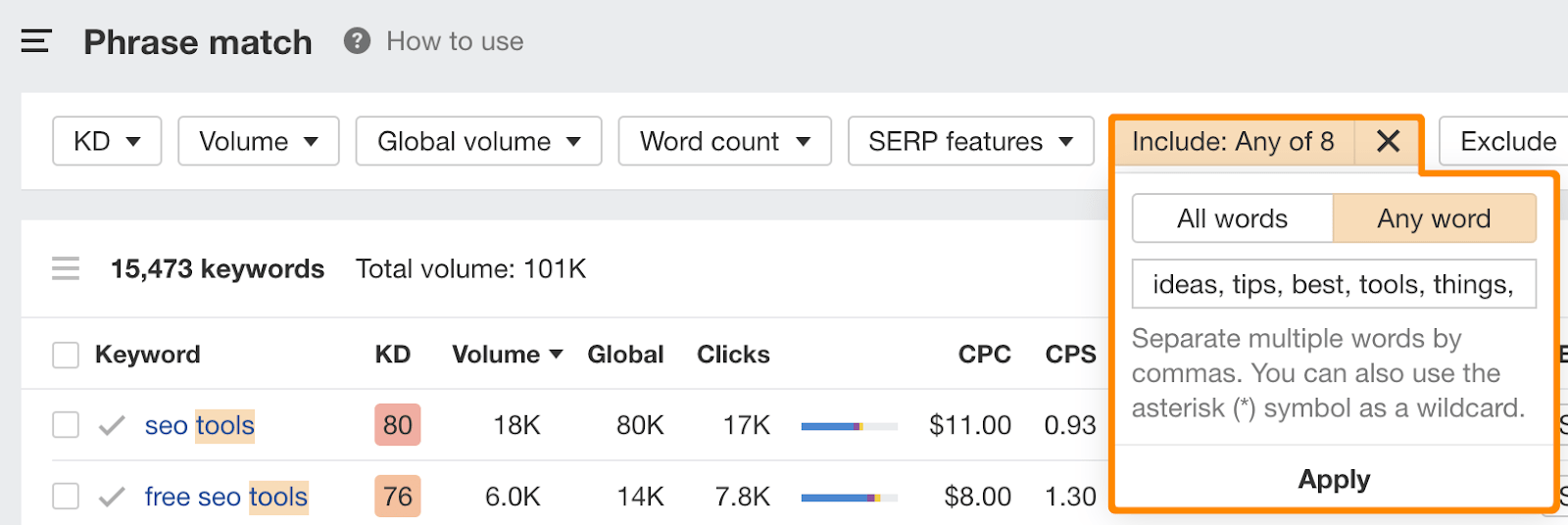
3. Decide on length
Generally speaking, the number of items on your list should roughly match the number of list items you see among top-ranking pages. After all, if they’re all well into the double or triple digits, then a list of five items probably isn’t what searchers are looking for.
For example, the top results for “date ideas” are lists of hundreds of ideas.

Whereas none of the top 5 results for “blogging tips” exceed 30.
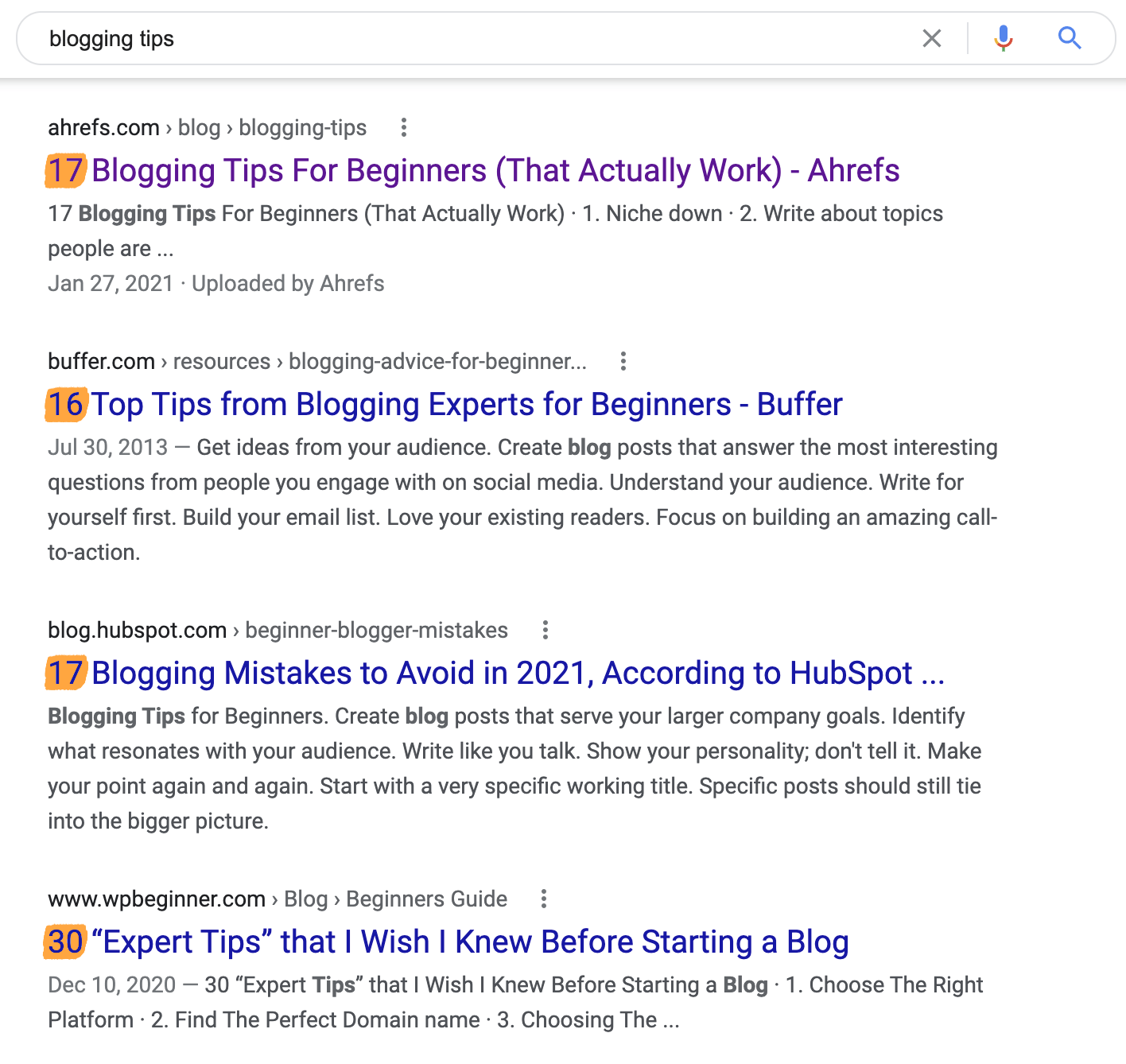
Is this a hard and fast rule? No. If you think a list of 100+ items is completely pointless and doesn’t actually help searchers, feel free to deviate from this advice. What we’re doing here is using the top-ranking results as a proxy for what searchers want, but it’s not 100% foolproof.
Plus, the length of your list may ultimately be restricted by the number of ideas you have, but it’s good to have a rough ballpark figure in mind to start.
4. Choose a format
There are two possible listicle formats.
a) Basic
Basic lists are short and sweet with 1-2 sentence descriptions for each list item. Use this format when one or both of the following are true:
- Your list will be long. People probably don’t want to read an essay about each of the 50+ items on your list.
- Your topic is simple. Let’s say you’re putting together a list of date ideas. Most of these are probably simple things like ‘go roller-skating’ or ‘go hiking.’ You don’t need to write 500 words about each of those things.
b) Detailed
Detailed lists are meatier lists where you expand on each point with a few sentences or paragraphs. Use this format when one or both of the following are true:
- Your list will be short. If your list will only have a few items, your post will probably attract more traffic if you provide more substance and details about each one.
- Your topic is complicated. Let’s say you’re putting together a list of SEO tips. SEO is a complicated topic, so readers will probably need practical advice or step-by-step instructions on how to execute each tip.
5. Choose a winning angle
Here are a few popular angles for listicles:
- Personal experience → 21 Best Online Marketing Tools That We Use At Ahrefs
- Best → 6 Best Marketing Podcasts
- Expert commentary → 33 Expert-Backed Decluttering Tips
- For beginners → 23 Blogging Tips For Beginners
- Specific outcome → 12 Quick SEO Tips to Increase Organic Traffic
- Tried and tested → 26 Best Free Chrome Extensions for SEOs (Tried & Tested)
Although you could choose an angle based solely on what feels most interesting, it’s better to take inspiration from the top results. Remember, these are the best proxy for what searchers want to see.
If we do this for the keyword “travel tips,” we see that most are based on personal experience:
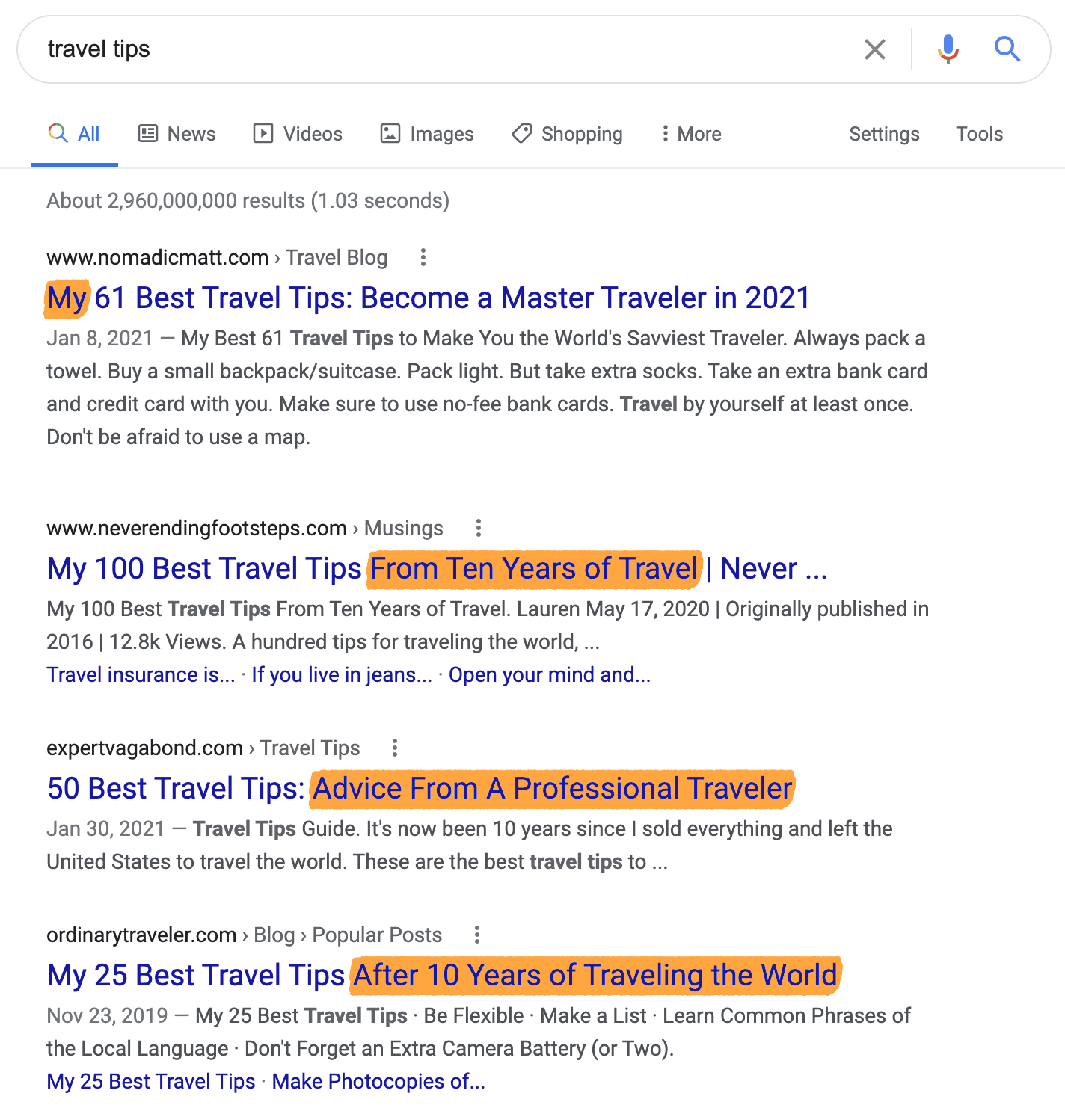
For “dinner ideas,” pretty much all results are focused on ease.
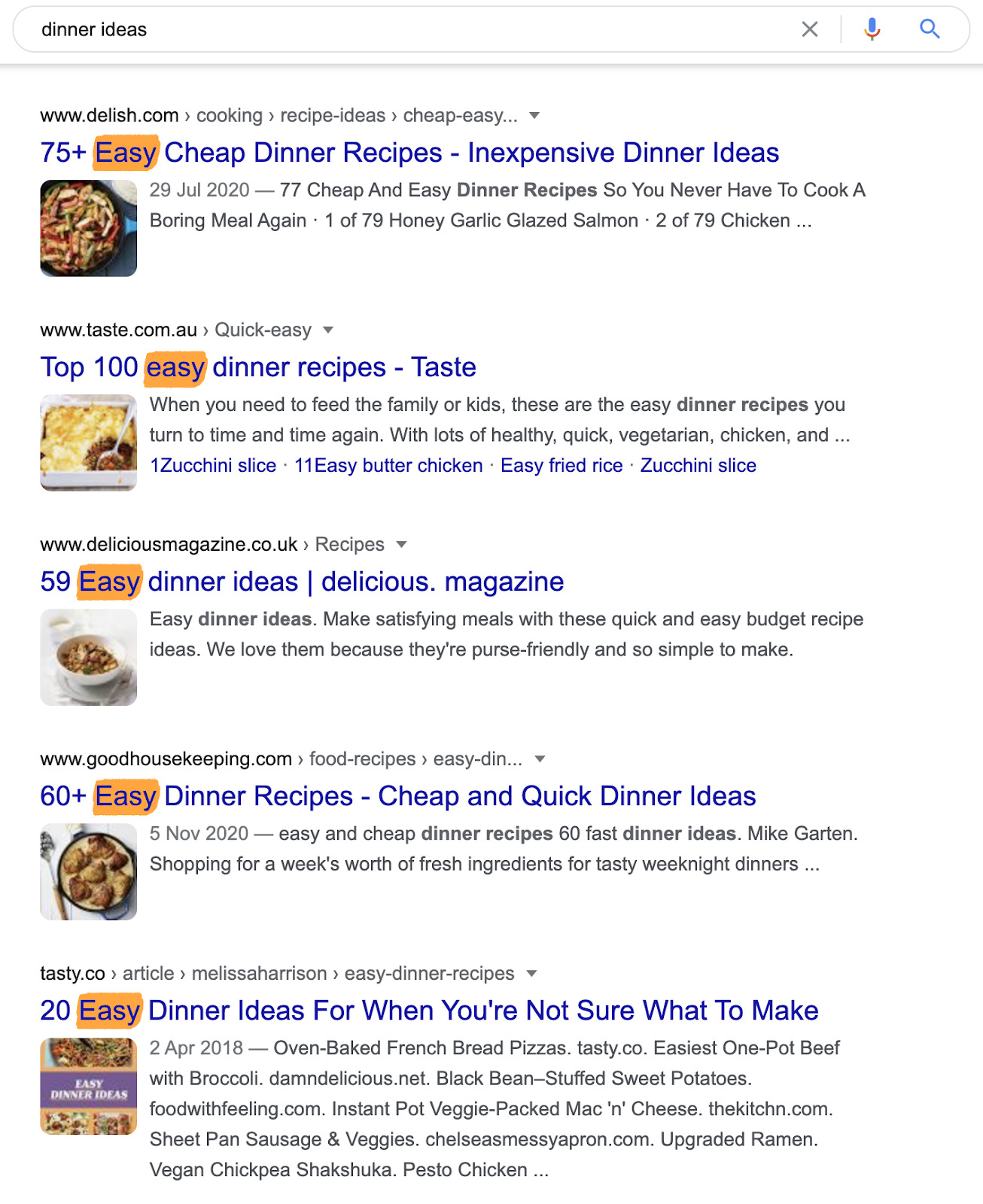
However, things aren’t always this clear-cut. Just look at the results for “marketing ideas” where there are two dominant angles: creative and free. The best one to choose is anyone’s guess.

Either way, make sure to stay clear of clickbait angles. If you can’t deliver on what your angle promises, choose something else.
6. Brainstorm list points
Bringing new and unique ideas to the table is crucial when writing a listicle (or any content for that matter). So while it might seem tempting just to copy everyone else, if all you create is a carbon copy of existing listicles, nobody will care about your post.
Even worse, it probably won’t attract backlinks, so it’ll be harder to rank in Google and get search traffic.
For that reason, you should jot down your own ideas before even thinking about what existing listicles on the topic have to say. This process doesn’t have to be complicated. Just open a blank doc and start listing potential ideas.

7. Expand on your ideas
Unless you’re super knowledgeable about a topic, you’ll probably struggle to come up with enough points for a comprehensive listicle on your own. Getting input from friends or colleagues is one way to solve that, but you can also take inspiration from the top-ranking pages.
Here are two ways to do that:
a) Use the “also talk about” report
Plug your target keyword into Ahrefs’ Keywords Explorer and go to the Also talk about report. This shows words and phrases frequently-mentioned by the top-ranking pages for your keyword.
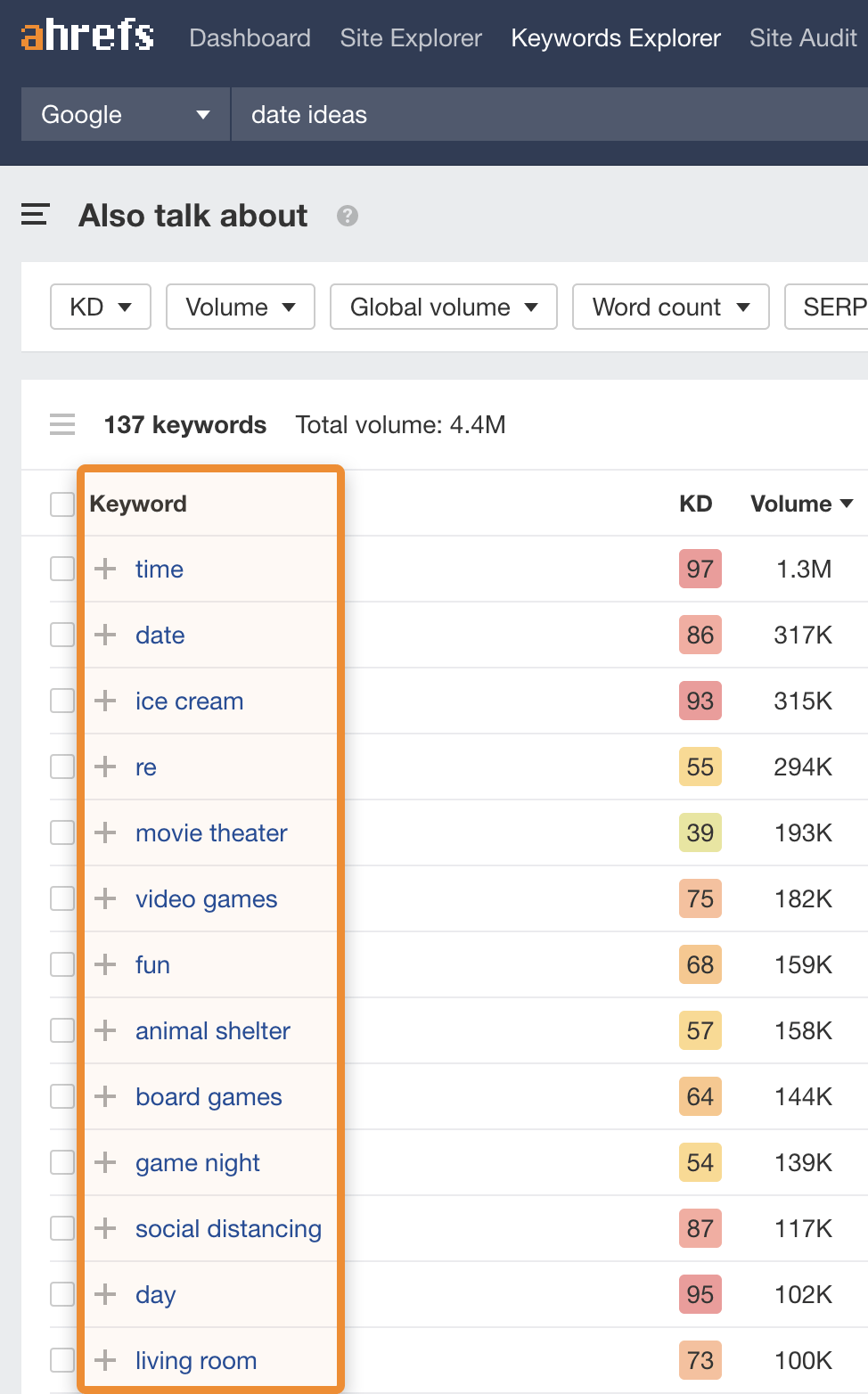
Not all of these words and phrases will be particularly insightful, so it’s best to eyeball the list for suggestions that could form the basis for potential points.
For example, here are a few words and phrases that show up for “date ideas”:
- ice cream
- movie theater
- animal shelter
- board games
- rock climbing
If we combine these ideas with our own knowledge and common sense, we can easily convert them into worthwhile points:
- Get ice cream
- Go to the movie theater
- Visit an animal shelter
- Play board games
- Go rock climbing
b) Check subheadings
Most listicles use subheadings for each point. So a good way to extract inspiration from top-ranking pages is to extract the subheadings. You can do this for free with Ahrefs SEO Toolbar. Just install it, open one of the top-ranking pages, then hit the little page icon in the top left for the on-page report.
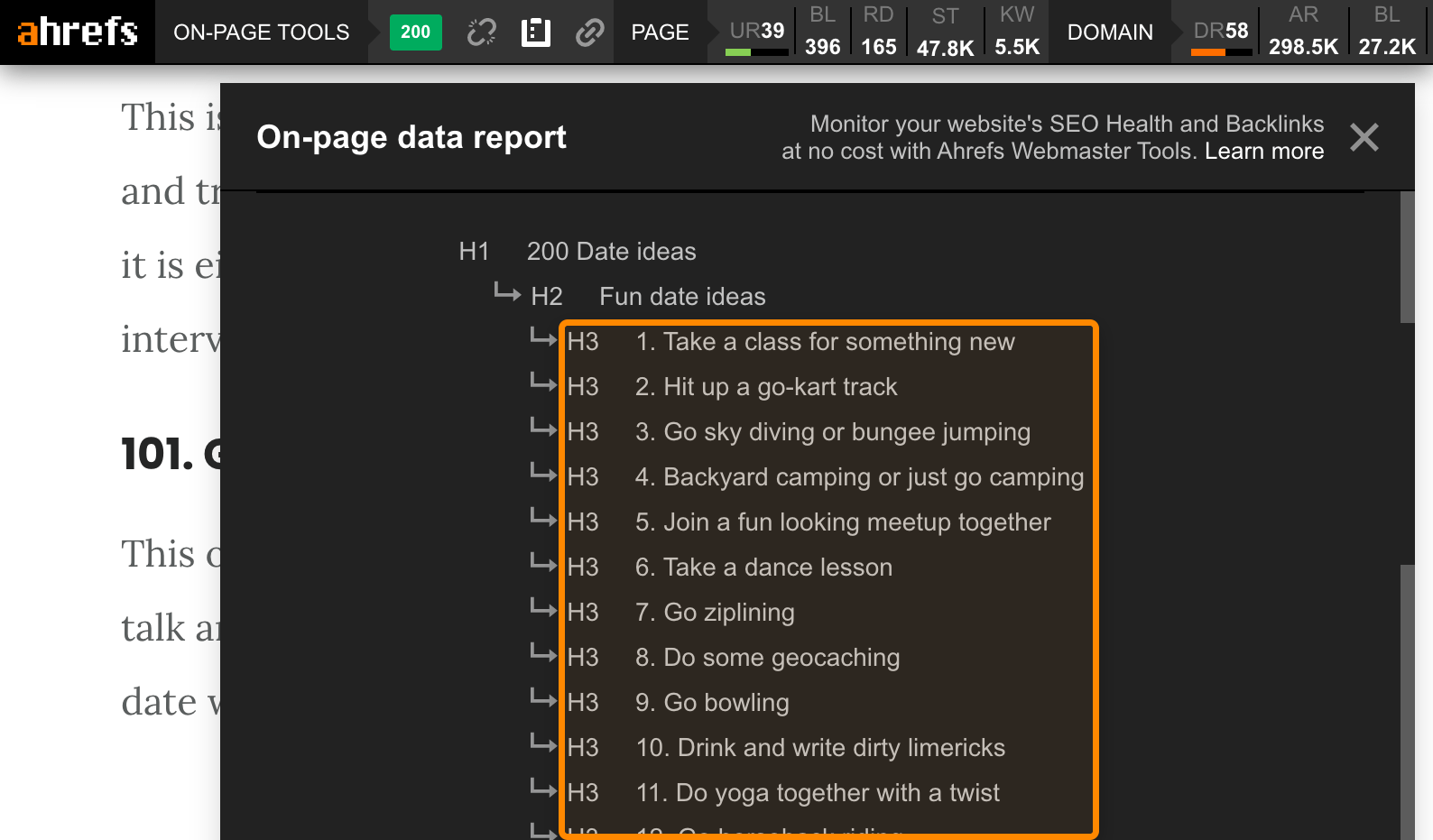
If you’re wondering why not just look at the pages directly, well, you can. But you can easily take too much inspiration that way. You might end up reading everything below the subheadings and your listicle soon becomes a carbon copy.
8. Flesh out each point
It’s now time to expand on each point and flesh out your listicle. The level of detail here will vary depending on the listicle format you’re going for.
- For simple lists. Add a couple of sentences to each point.
- For detailed lists. Write as much as it takes to explain each point in detail.
Keep the angle of your listicle in mind when doing this. If you’re writing a listicle aimed at beginners, you’ll want to avoid unnecessary jargon and details. If your listicle is based on personal experience, now’s the time to expand on that with further thoughts and opinions.
9. Illustrate your points
Listicles are easy to skim and digest. But they’re arguably even easier to digest when you break things up with images and illustrations. This becomes even more important when you want readers to actually remember the points in your listicle thanks to the picture superiority effect.
According to Wikipedia:
The picture superiority effect refers to the phenomenon in which pictures and images are more likely to be remembered than words. This effect has been demonstrated in numerous experiments using different methods.
If you’ve read any of our listicles, you’ll know that we include plenty of images. For example, our list of 17 marketing ideas contains 39 images. That’s because marketing is a complicated subject and some points are hard to understand without images to illustrate. You don’t have to use so many images in your listicles, so don’t force them in for the sake of it.
10. Wrap things up
Listicles have a tendency to end abruptly. You get to the final point and things kind of just stop.
It’s easy to see why. Most listicle readers are skimmers, so they probably wouldn’t bother to read a conclusion anyway. But that’s no reason not to include one. For the folks that read your listicle from start to finish, a good conclusion can help wrap things up and drive the point home.
Here are a few tips for writing a good conclusion for your listicles:
- Keep it short.
- Don’t repeat points you already made.
- Focus on the main point you want to drive home.
- Link to other relevant posts (they don’t have to be listicles).
Given that we roughly follow this advice for our own listicles, we thought we’d wrap things up by sharing a few listicles from our own blog that rank high and drive lots of organic traffic.
- 7 Alternative Search Engines to Google: 11K+ monthly search visits
- 7 Ways To Find Anyone’s Email Address: 8K+ monthly search visits
- 7 Successful Amazon Affiliate Websites: 3.5K+ monthly search visits
- 12 Quick SEO Tips: 3K+ monthly search visits.
- 10 Ways to Get Google to Index Your Site: 2.5K+ monthly search visits
- 9 Easy Link Building Strategies: 1.3K+ monthly search visits
- 4 Simple Blog Post Templates: 1.2K+ monthly search visits.
Final thoughts
Not all listicles are created equal. Just because Buzzfeed’s listicles are the lowest common denominator doesn’t mean yours need to be. Choose the right topic, angle, format, put some effort into the content, and you have a recipe for organic success.
Got questions? Ping me on Twitter.




